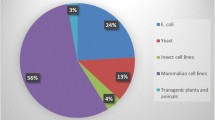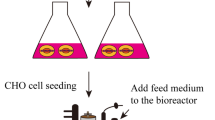Abstract
The design of serum-free media for suspension culture of genetically engineered Chinese hamster ovary (CHO) cells using general commercial media as a basis was investigated. Subcultivation using a commercial serum-free medium containing insulin-like growth factor (IGF)-1 with or without FCS necessitated additives other than IGF-1 to compensate for the lack of FCS and improve cell growth. Suspension culture with media containing several combinations of growth factors suggested the effectiveness of addition of both IGF-1 and the lipid signaling molecule lysophosphatidic acid (LPA) for promoting cell growth. Subcultivation of CHO cells in suspension culture using the commercial serum-free medium EX-CELL™302, which contained an IGF-1 analog, supplemented with LPA resulted in gradually increasing specific growth rate comparable to the serum-containing medium and in almost the same high antibody production regardless of the number of generations. The culture with EX-CELL™302 supplemented with LPA in a jar fermentor with pH control at 6.9 showed an apparently higher cell growth rate than the cultures without pH control and with pH control at 6.8. The cell growth in the medium supplemented with aurintricarboxylic acid (ATA), which was much cheaper than IGF-1, in combination with LPA was synergistically promoted similarly to that in the medium supplemented with IGF-1 and LPA. In conclusion, the serum-free medium designed on the basis of general commercial media could support the growth of CHO cells and antibody production comparable to serum-containing medium in suspension culture. Moreover, the possibility of cost reduction by the substitution of IGF-1 with ATA was also shown.






Similar content being viewed by others
References
Beery R, Haimsohn M, Wertheim N, Hemi R, Nir U, Karasik A, Kanety H, Geier A (2001) Activation of the insulin-like growth factor 1 signaling pathway by the antiapoptotic agents aurintricarboxylic acid and evans blue. Endocrinology 142:3098–3107
Brown KD, Littlewood CJ (1989) Endothelin stimulates DNA synthesis in Swiss 3T3 cells. Synergy with polypeptide growth factors. Biochem J 263:977–980
Chu L, Robinson DK (2001) Industrial choice of protein production by large-scale cell culture. Curr Opin Biotechnol 12:180–187
Dingermann T (2008) Recombinant therapeutic proteins: production platforms and challenges. Biotechnol J 3:90–97
Goetzl EJ, An S (1998) Diversity of cellular receptors and functions for the lysophospholipid growth factors lysophosphatidic acid and sphingosine 1-phosphate. FASEB J 12:1589–1598
Holdsworth G, Slocombe P, Hutchinson G, Milligan G (2005) Analysis of endogenous S1P and LPA receptor expression in CHO-K1 cells. Gene 350:59–63
Houben AJ, Moolenaar WH (2011) Autotaxin and LPA receptor signaling in cancer. Cancer Metastasis Rev 30:557–565
Johansson GS, Arnqvist HJ (2006) Insulin and IGF-I action on insulin receptors, IGF-I receptors, and hybrid insulin/IGF-I receptors in vascular smooth muscle cells. Am J Physiol Endocrinol Metab 291:E1124–E1130
Liu C, Chu I, Hwang S (2001) Aurintricarboxylic acid exerts insulin-like growth stimulating effects on Chinese hamster ovary cells under serum-free conditions. J Biosci Bioeng 91:576–580
Luttrell LM (2005) Composition and function of G protein-coupled receptor signalsomes controlling mitogen-activated protein kinase activity. J Mol Neurosci 26:253–264
Luttrell LM, Gesty-Palmer D (2010) Beyond desensitization: physiological relevance of arrestin-dependent signaling. Pharmacol Rev 62:305–330
Luttrell LM, Daaka Y, Lefkowitz RJ (1999) Regulation of tyrosine kinase cascades by G-protein-coupled receptors. Curr Opin Cell Biol 11:177–183
Moolenaar WH (1996) Lysophosphatidic acid, a multifunctional phospholipid messenger. J Biol Chem 270:12949–12952
Pak SC, Hunt SM, Bridges MW, Sleigh MJ, Gray PP (1996) Super-CHO-A cell line capable of autocrine growth under fully defined protein-free conditions. Cytotechnology 22:139–146
Rasmussen B, Davis R, Thomas J, Reddy P (1998) Isolation, characterization and recombinant protein expression in Veggie-CHO: a serum-free CHO host cell line. Cytotechnology 28:31–42
Rozengurt E (1986) Early signals in the mitogenic response. Science 234:161–166
Sakai K, Matsunaga T, Yamaji H, Fukuda H (1999) Effects of phospholipids on growth of Chinese hamster ovary cells in serum-free media. J Biosci Bioeng 88:306–309
Schröder M, Matischak K, Friedl P (2004) Serum- and protein-free media formulations for the Chinese hamster ovary cell line DUKXB11. J Biotechnol 108:279–292
Tigyi G, Fischer DJ, Baker D, Wang DA, Yue J, Nusser N, Virag T, Zsiros V, Liliom K, Miller D, Parrill A (2000) Pharmacological characterization of phospholipid growth-factor receptors. Ann N Y Acad Sci 905:34–53
Urlaub G, Chasin LA (1980) Isolation of Chinese hamster cell mutants deficient in dihydrofolate reductase activity. Proc Natl Acad Sci USA 77:4216–4220
van Corven EJ, Groenink A, Jalink K, Eichholtz T, Moolenaar WH (1989) Lysophosphatidate-induced cell proliferation: identification and dissection of signaling pathways mediated by G proteins. Cell 59:45–54
van Corven EJ, van Rijswijk A, Jalink K, van der Bend RL, van Blitterswijk WJ, Moolenaar WH (1992) Mitogenic action of lysophosphatidic acid and phosphatidic acid on fibroblasts. Dependence on acyl-chain length and inhibition by suramin. Biochem J 281:163–169
van der Pol L, Tramper J (1998) Shear sensitivity of animal cells from a culture-medium perspective. Trends Biotechnol 16:323–328
Yun Z, Takagi M, Yoshida T (2003) Combined addition of glutathione and iron chelators for decrease of intracellular level of reactive oxygen species and death of Chinese hamster ovary cells. J Biosci Bioeng 95:124–127
Zhang H, Wang H, Liu M, Zhang T, Zhang J, Wang X, Xiang W (2013) Rational development of a serum-free medium and fed-batch process for a GS-CHO cell line expressing recombinant antibody. Cytotechnology 65:363–378
Author information
Authors and Affiliations
Corresponding author
Rights and permissions
About this article
Cite this article
Miki, H., Takagi, M. Design of serum-free medium for suspension culture of CHO cells on the basis of general commercial media. Cytotechnology 67, 689–697 (2015). https://doi.org/10.1007/s10616-014-9778-0
Received:
Accepted:
Published:
Issue Date:
DOI: https://doi.org/10.1007/s10616-014-9778-0




